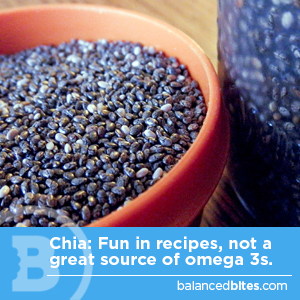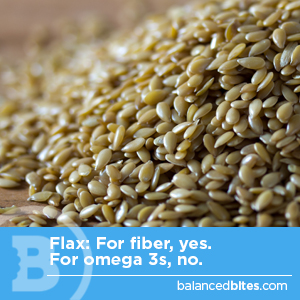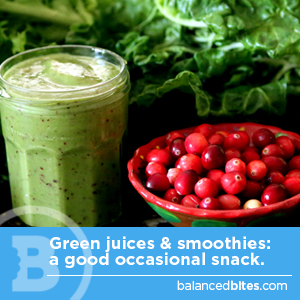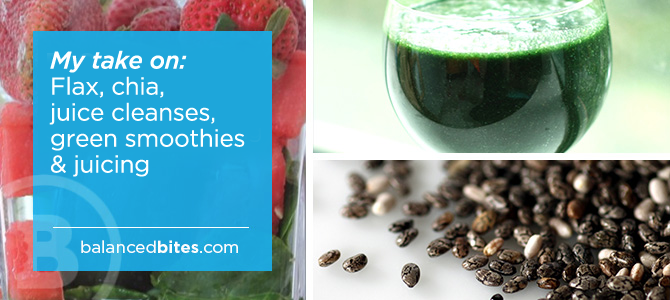Those of you who follow my blog and listen to my podcasts know that I am not particularly dogmatic about what is “allowed” and “not allowed” on a Paleo/Primal/Real Foods type of diet. My approach is to help you understand how food should work in your body and empower you to choose foods that provide optimal, nutrient-dense fuel for your body.
If you have all your health and fitness goals met and you feel that flax, chia, juice cleanses, green smoothies and/or juicing are adding value to your nutritional approach, I’m not here to tell you they're going to harm your health – because I don't believe that they will.
That said, if you are just starting out, have digestive issues, and/or are still tweaking your diet for better results, my short answer is this: leave them out entirely for now.
Flax and Chia
 Eating or using flax or chia seeds occasionally if you are not dealing with any digestive issues is probably not any big deal.
Eating or using flax or chia seeds occasionally if you are not dealing with any digestive issues is probably not any big deal.
I definitely don't consider them “super foods” or recommend them for regular use as supplements. It can be easy to get caught up in the hype of getting some “anti-inflammatory” Omega-3/alpha linoleic acid (ALA) from flax and chia seeds; however, the conversion of ALA to EPA and DHA is extremely limited in humans. Less than 5% of ALA gets converted to EPA, and less than 0.5% (one-half of one percent) of ALA is converted to DHA [1]. That means you'd need to consume a ton of plant-based omega-3 rich oils to get the recommended amount of EPA/DHA for humans on a regular basis. To read more about my position on balancing Omega-3/Omega-6 fats, check out this post.
Chia seeds can be fun in things like the a GT's Kombucha or in an occasional recipe for their gelatinous properties. These seeds can also be called a “pseudo grain” and many people cannot tolerate them without some real digestive upset.

I know that a lot of folks like to use a flax mixture as an egg replacer and, again, I don’t have a problem with that as long as there are no underlying issues you are trying to resolve. Although there are cases where flax is being used therapeutically (under the guidance of a practitioner) for certain conditions, such as estrogen detox (as addressed Charles Poliquin’s post: 10 Ways To Lower Estrogen Toxic Load) that’s not what I am addressing here. As a side note, never heat flax oil. See my free downloadable guide to Fats and Oils for more information.
My overall take:
Flax and chia seeds can be fun in recipes, may be helpful for fiber intake, and useful if you are intolerant to eggs as a binder in some of those recipes. But if you think you're getting useful omega 3 fatty acids from either of these plant-based sources, think again. They're more useful for fiber and texture in your food than for any deep nutritional benefits.
Juice Cleanses, Juicing, & Green Smoothies
By now you know how I feel about the fact that we should be chewing and eating food (I also addressed this in FAQ regarding protein powder). That said, although I am not a fan of juice cleanses. Green smoothies and juicing really depends on where you are at with your health and body composition goals, how you are consuming them, and what you are putting in them.
Juice Cleanses
Correct or not, the idea behind a “juice cleanse” is to “detoxify” or lose weight. If you are someone that normally eats grains, processed dairy and other refined foods, and you give yourself a break from those, well, you might feel better and lose weight, however, the results are not likely what you think they are. And if you are not fixing your day to day nutrition – the results will be temporary.
You might also feel horrible if you suddenly overburden your detoxification pathways. Charles Poliquin compares the detoxification process to a three-step program to take out the garbage in your house. He states in this article: “The idea is to keep everything balanced. If we want to improve detoxification, the entire process must be supported with adequate nutrient intake. Just as we don’t want the garbage cans overflowing, we also want to be sure all the toxins we’re trying to get rid of are fully removed from our bodies.”
My concern with juice cleanses, is that you unnecessarily deplete yourself of essential nutrients, spike your blood sugar, and due to the calorie deficit – force your body to run on cortisol. Your adrenals take a hit-the last thing you want to do if you are looking to improve your health. Also, amino acids from protein are required in the phase II detoxification pathway, so it makes little sense that a “cleanse” or “detox” could actually do what it is intended without tapping into your muscle tissue.
My overall take:
You don’t need to complete a juice cleanse to detoxify yourself from the ill effects of processed/refined foods – you can do it naturally, 24/7, with the balanced approach of nutrient dense whole food, optimizing digestion, moving, stress reduction, and by reducing the toxins in your environment. If you are seeking a guided program for starting Paleo or maybe you are looking for a reset after over-indulged during a holiday, long-term travel or stress, you can check out my 21-Day Sugar Detox. The program offers a balanced approach to naturally detoxing with real food. You get e-mails, recipes, an extensive, customizable program guide, and lots of other bonus materials.
Green Smoothies & Juicing
 Green smoothies and “juicing” are NOT on my list of superfoods and my take on them, like many grey-area foods is: it depends.
Green smoothies and “juicing” are NOT on my list of superfoods and my take on them, like many grey-area foods is: it depends.
The term “Green Smoothie” is confusing.
What makes a smoothie “green”? Does it mean all greens, some greens, and what exactly goes with the greens?
What does “juicing” mean? You will likely get different interpretations depending on who you ask. Does it contain fiber? Fruit? How much?
If you are making them yourself, based on what you put in them – including how many actual green vegetables go into them – I think they are fine for an occasional snack or addition to your regular diet – especially if you are someone that has a hard time getting in enough calories.
I don't think they should be consumed in place of a real meal, or even as a “supplement” in place of whole vegetables.
Some people believe they help their digestion, others find a green smoothie or a “juicing” drink can be a digestive nightmare. Too many raw greens can be a punch in the gut if your digestion is compromised (including leaky gut, candida, or have other fungal challenges), especially if you have an oxalate sensitivity as Chris Kresser addresses in this podcast. Additionally concerning, is the connection of kidney stones to high oxalate containing foods such as raw spinach, also addressed in Chris’s podcast.
Of course if you are not careful, any smoothie or juice drink, depending on what you are putting in it, can contribute to a big insulin spike, proceeded by a crash – definitely not what you’re looking for when you are trying to optimize your health.
There are also folks who find that the nutrient-punch from green juices (heavy on the vegetables, light on or with almost no fruit) aide in detoxification by supplying the liver with extra sulfur compounds and phytonutrients to carry out detoxification functions. That's a perfectly legitimate and valid reason to enjoy green juice.
My overall take:
If you are struggling with weight issues, I'd avoid smoothies until you have reached your goal. Assuming your digestion is all good, and you don’t throw too many greens (as in 1-2 handfuls-not 5 servings!) or too much fruit into the blender, you can make some decent smoothies that are green. Don’t forget the FAT – vegetables are better assimilated when ingested with good fats (Chris Kresser does an excellent job pointing a handful of studies that show why fat with veggies is a good idea.)
Green juices should be viewed as supplemental in the “in addition to” way with regards to your over all diet, not an “instead of” way as some folks may attempt to avoid whole vegetables.
Some ingredients that are great to combine for a “modified” green smoothie” or “juicing” drink include:
- organic coconut milk
- coconut water (no sugar added)
- fresh or frozen fruit – bananas, berries, mango, pineapple, lemon
- egg yolks – from organic pastured eggs only (for calories and fat, not ideal for athletes post-workout refueling but may be helpful for pre-workout or adding calories for adding mass)
- organic almond butter or other nut butter (for calories and fat, not ideal for athletes post-workout refueling but may be helpful for pre-workout or adding calories for adding mass)
- avocados
- handful or 2 of greens
For green juice, my favorite ingredients are:
- kale, spinach, or other dark green leafy vegetables like collards (for nutrient-density)
- cucumber (for the water content and great, fresh flavor)
- celery (for the water content and fresh flavor)
- green apple (for sweetness, just about 1/4 of an apple per serving is plenty – or even less)
- lemon juice (I absolutely love the flavor and tartness, but sour foods are are also supportive of the liver)
- beets (in small amounts, they add sweetness and great nutrient density)
- carrots (in small amounts, they add sweetness and great nutrient density)
This is the juicer I own and love – the Omega J8005.
Here’s a Green Monster Smoothie recipe developed by Our Full Plate and a yummy looking Creamy Green Apple Smoothie recipe by PaleOMG – both of which are 21-Day Sugar Detox compliant – enjoy (sporadically)!
And, check out another great take from Grass Fed Girl, Nutrition Consultant Caitlin Weeks, on why juicing may not be so healthy.
Sources: [1] Kresser, Chris. “Why Fish Stomps Flax as a Source of Omega-3.” Chris Kresser RSS. Chris Kresser, 5 May 2010. Web. 30 June 2013.


Comments 27
here’s what was in my smoothie today – 1 cup coconut milk (made from tropical traditions coconut creme concentrate – 1T of coconut creme with 8 ozs filtered water), 2 handfuls of organic spinach,1T of hemp seeds (hulled),1T of Inner-Eco coconut kefir, 1/2 tsp of cinnamon, 1/2 avocado,2 scoops JJ Virgin protein powder, handful of organic blackberries, 1 scoop of Amazing Grass Greens,1T MCT oil. Although a bunch of healthy fats, still gives me a sugar hit (from 90 to 135 after 2 hours) due to all that blending, even if I leave out the blackberries. Healthy in some ways – maybe not in others. Convenient – yes. Tasty – yes. Good for my diabetes – not particularly. A bit hard to digest – yes, all those greens tend to produce gas with my rather sensitive guts, even when taking pre/probiotics such as Prescript-Assist. So I tend to agree with your article, although I also realize it is a nice switch from eggs and is a big part of the reason I started consuming smoothies – to get away from eggs every day (eating Paleo). I realize I would be better off eating whole foods the old fashioned way, but sometimes in those groggy mornings, my imagination fails me. 🙂
What about some parsnip and sausage hash? That’s some carbs with protein and fat, but in food-you-chew form, vs a drink– and it’s pretty fast!
Thank you for this. A few thing I want to add. Flax and chia are also susceptible to rancidity that few people often think of. And i agree about using them with caution as fibre source – chia has given me the most incredible poops – and the scariest ones – based on my health at the time.
I run seasonal community cleanses throughout the year. I am NOT a cleanse fanatic at all – in fact I’m in more of the non-cleanse boat – that’s why I began them. I saw how ridiculously everyone was trying to “cleanse” with juicing in January, scary colon kits off the shelf or making raw green smoothies while dealing with underlying thyroid issues, etc. It’s difficult to deal with all the many types of constitutions while running a GROUP cleanse. I’m a holistic nutritionist who believes our needs vary person-to-person, constitution-to-constitution. (I eat a mostly Paleo diet but I still incorporate some PROPERLY PREPARED pseudo seeds and some legumes in from time-to-time.) Green smoothies make great OCCASIONAL snacks, for SOME people, with added fat, not TOO much fruit, etc. THIS is why we need to get the word out there – there is just so much people don’t consider when eating these supposed “super-foods” or cleansing. Boy oh boy, I could go on. But mostly I just want to thank you for this post. Cheers!
Agreed on the rancidity factor!
Thank you for writing this, I am a big fan of your work!
Quick question: Why don’t you recommend egg yolks post workout and what would you suggest instead??
Thanks!
What you need most post-workout are carbs and some protein. Fat isn’t as useful at that time.
Thank you! So would you recommend I use the entire egg? Sorry if I’m bugging you-eggs are just so easy to throw into things!
In a smoothie- yolk only. Any other time when cooked – whole eggs for sure. I cover this in my book a bit as well.
Great! Thanks.:) Your book is on my list!!
Do you hear that, Fezzik? That’s the sound of ultimate suffering. My heart made that sound when I realized I just spent $600 on a blender, and now shouldn’t make green smoothies.
Just don’t do it all the time with tons of raw leafy greens – you’ll make use of the blender. It’ll be with you for many years.
Absolutely (although I was kinda making a Princess Bride-style joke).
I have a client who spent OVER that on a blender and its options, and when she came over and saw that I used a $29 blender from Target, her heart made that sound. 😀
Fun read, thanks!
Funnily enough I was having this exact conversation with another Paleo blogger today. I’ve never juiced, but wonder why so many people promote it – was feeling the pressure to try! Thanks for laying out an explanation so perfectly!
Flax totally makes me bloated, but I really do love it! LOL!
These is my second time to come across some hesitations about green smoothie. If I remember it right, the article I read says that the veggies that we usually use fr smoothies contain high oxalates, which when taking overtime will lead to serious health problems like oxalate toxicity which resort to oxalate stones passed out by the kidney. Nonetheless, precaution is the great prevention so might as well cut down on my green smoothies which I have accustomed to. I will heed your advice on varying smoothie ingredients, or might even consider juicing as an alternative instead of smoothies.
Here is the link to that article I read about precautions on green smoothies: http://www.thehealthyhomeeconomist.com/how-green-smoothies-can-devastate-your-health/.
I’m now on a low oxalate diet because of the overabundance of spinach, kale, sweet potatoes, beets, nuts (especially almonds) and nut butters in my diet. I realize this is an older article from Diane, but I would love if she addressed the oxalates more in a future podcast. I appreciate the link to Chris Kesser’s info on the subject. I think high oxalates is becoming a real problem in the Paleo, Whole30 and surely vegan/vegatarian worlds! Not many people are aware of what an oxalate even is!
Author
The BB Podcast has closed at this time, but if you eat foods that work for you, that’s ideal – paleo or not! 🙂
I also believe the green smoothie thing needs to be tempered. It’s one of those “health” concepts that’s really easy to sell as helpful. I mean, just look at them — anything green must be healthy right? But, they present a lot of problems, often doing more harm than good. Thanks for pointing this out.
I suggest you consider Brian Peskin’s view of the EFAs and whether we really need to consume EPA and DHA. He’s adamant that we don’t and shouldn’t supplement with them.
I occasionally make a green smoothie when I’m tired of eggs for breakfast. I have also started making them occasionally for my 6 year old, who is going through a phase of not wanting to eat many green vegetables. I make him a variety of types, but will toss in a handful of raw spinach, kale or broccoli with a banana, some strawberries or blueberries, and greek yogurt. Thoughts on this approach for kids? (my kids aren’t paleo…yet!)
Author
We’ve talked about feeding kiddos on the podcast a bunch, I’d recommend checking out the archives!
organic almond butter or other nut butter (for calories and fat, not ideal for athletes post-workout refueling but may be helpful for pre-workout or adding calories for adding mass)
Why isn’t almond butter ideal for athletes post workout?
Author
Protein and carbs are better in the post workout time frame for replenishing nutrients than fat.
Hi – I am using a sprouted flax seed to use as egg replacer and added to my homemade almond milk to make a pudding. I have lots of digestive issues that I am recovering from and seem to tolerate it. I am also tolerating a small amount of sprouted quinoa. When you are on a paleo, AIP, fodmap free diet, some variety is needed!
Hi Diane, Do you have a juicer that you recommend or have? If you posted it before, I apologize. Thanks so much!
Hi Diane, I’ve been concerned about the insuline spike, I’ve been trying an adrenal juice that I’m sure you’ve hear of it is the orange one with salt and coconut cream plus collagen, what dou think about that, my body seems to need that but I crave sweets all day after it. Do you recommend something else for energy?